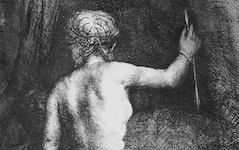Rembrandt’s Anatomy Lesson of Dr. Tulp (1632)
Little is known about this painting by Rembrandt though it appears to be a group portrait commissioned by Dr Tulp. Thus art scholars, with virtually no historical evidence, have long tried to describe it as a realistic depiction of an actual event.1 Yet the young Rembrandt would have wanted to paint poetry not a historical record as the visual inconsistencies suggest. On this poetic level, Dr. Tulp is his alter ego “painting” the corpse with the audience marveling at his art. One art historian almost said so.
Dr. Tulp looks detached from the scene, a cut-out figure lit perhaps from a different light source. The corpse, which others have noted is colored and also lit unnaturally, is Rembrandt’s “painting” with the additional hint that the arm looks more like an anatomical illustration than a dissected corpse. Besides, in life, anatomists cut the torso first and also left the messy procedure to assistants.2 Svetlana Alpers observed that Rembrandt identified with Tulp and that the corpse represents his paint (she could have said his painting), the surgeon having cut it like Rembrandt applied it.3 The reason for the arm alone being dissected is now clear: the arm and hand are symbols of Rembrandt’s craft.
Centuries later in Edouard Manet’s copy of this painting, the doctor leans to the right instead of the left, his hands slightly further apart in a gesture that Manet used elsewhere to indicate an unseen brush in one hand hovering over the unseen palette in the other.4 That means Manet saw Dr. Tulp as Rembrandt long before any art scholar weighed in.
More Works by Rembrandt
It can be difficult to explain why Rembrandt portrayed himself as a beggar. Here's what I think...

Rembrandt’s Self-portrait as A Beggar Seated on a Bank (1630)
Notes:
1. The most complete study is from half a century ago: William S. Heckscher, Rembrandt’s Anatomy of Dr. Nicolaas Tulp: An Iconological Study (New York: New York University Press) 1958
2. For the corpse’s coloring: A.B. De Vries, Magdi Tóth-Ubbens and W. Froentjes: Rembrandt in the Mauritshuis (The Hague: Sijthoff & Noordhoff) 1978, p. 107. For the sequence: Jonathan Sawday, The Body Emblazoned: Dissection and the Human Body in Renaissance Culture (London and New York: Routledge) 1995, p. 150
3. Svetlana Alpers, Rembrandt’s Enterprise: The Studio and the Market (The University of Chicago Press) 1988, p. 81
4. See other images from Manet’s early years including Woman with a Jug, the maid’s raised hand in Manet’s Olympia, the guitarist in The Music Lesson, his engraving At The Prado II.
Original Publication Date on EPPH: 20 Apr 2010. | Updated: 0. © Simon Abrahams. Articles on this site are the copyright of Simon Abrahams. To use copyrighted material in print or other media for purposes beyond 'fair use', you must obtain permission from the copyright owner. Websites may link to this page without permission (please do) but may not reproduce the material on their own site without crediting Simon Abrahams and EPPH.



